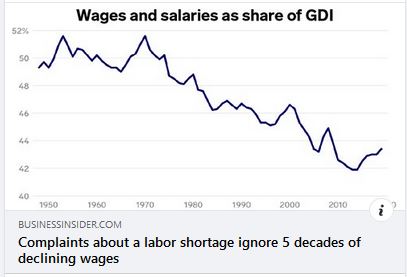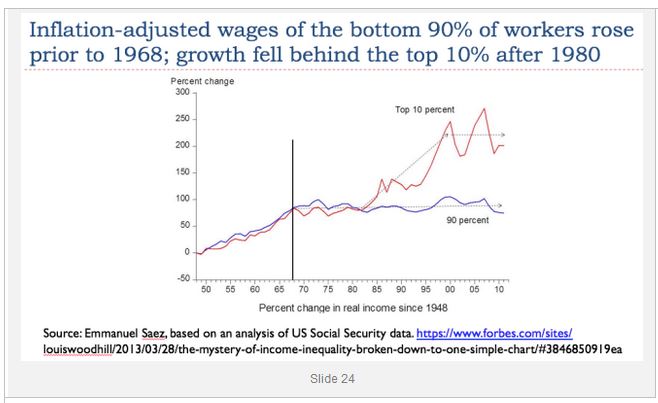“The term secular stagnation refers to a market economy with a chronic (secular or long-term) lack of demand. Historically, a booming economy with low unemployment and high GDP growth (i.e., an economy at or above capacity) would generate inflation in wages and products. However, an economy facing secular stagnation behaves as if it is operating below capacity, even when the economy appears to be booming; inflation does not appear. In a healthy economy, if household savings exceed business investments, interest rates fall; lower interest rates stimulate spending and investment, which bring savings and investments into balance. However, an economy facing secular stagnation may require an interest rate below zero to bring savings and investment into balance. The surplus of savings over investment may be generating price appreciation in financial assets or real estate. For example, the U.S. had low unemployment but low inflation in the years leading up to the Great Recession, although a massive housing bubble developed.[8]” (Wikipedia definition
Corporate Finance Institute puts it this way—
Summary
- The theory of secular stagnation was first put forward in the 1930s, during the Great Depression, and more recently revived by economist Lawrence Summers, who served as an economic advisor in both the Clinton and Obama administrations.
- The primary tenets of the theory are that the lack of investing, due to an increased tendency toward saving, and the lack of an aggressive (i.e., high spending) government fiscal policy are the primary causes of a state of economic stagnation, where there is little discernible economic growth.
- Opponents of the secular stagnation theory argue that the theory’s alleged condition of exaggerated saving is largely a myth and that the true culprit holding down economic growth is increased government regulation and fiscal intervention.
In this blog post we will be referring to the secular stagnation of wages particularly in the United States. The chronic lack of demand mentioned in the Wikipedia definition derives from, has its origin in, the stagnation of wage rates. We consider it *secular* because we can date this stagnation of wage rates to a specific time in recent history, which was the rise of the Reagan-Thatcher form of neoliberal economics. A core factor in this neoliberalism which has dominated for the past four decades is the weakening and ultimately destruction of the labor unions in the USA, and in the UK, the Labour Party.
Wage Stagnation in Charts & Graphs
In making a case for the connection of real-wage stagnation and “Peak Inequality” in the USA, you need to look at a bunch of data. Much of this is available in the visual format, charts and graphs. The first line graphs come from this source. Note the disclaimer on “Epistemic Status.”
Wage Stagnation: Much More Than You Wanted To Know
Posted on February 25, 2019 by Scott Alexander
“[Epistemic status: I am basing this on widely-accepted published research, but I can’t guarantee I’ve understood the research right or managed to emphasize/believe the right people. Some light editing to bring in important points people raised in the comments.]”

A more recent chart was published by Pew Research more recently.

This chart measures wages vs GDI, Gross Domestic income and is published by Business Insider. Investopedia defines
Gross Domestic Income with a key takeaway that
“The most significant component of GDI is wages and salaries; historically, roughly 50% of all national income has gone to workers.”

Critical insights from Our Finite World: When wages of non-elite workers are inadequate to drive economic growth
Retired actuary Gail Tverberg was a constant contributor to the peak-oil theory blog The Oil Drum, which is now discontinued. But she maintains her own site under the title Our Finite World.
In Gail’s finite world, the wages of the base-level working class, what she calls the “non-elite workers” are also of prime concern when examining the current “growth economy” orthodoxy and its failure—and how an economic collapse may be in the future for this economy.
Tverberg typically begins an essay with a discussion on the energy situation in the economy–whether there is adequate cheap, easy-to-get energy to continue powering growth forward. But then she inevitably turns toward the problem of the wages of the lowest segment of our working class:
“The wages shown on Slide 24 have already been inflation adjusted. Thus, in the period before 1968, wages for both the lower 90% of workers and for the top 10% of workers were rising rapidly, even considering the impact of inflation. Many families were able to afford a car for the first time. After 1980, the wages of the top 10% rose much more quickly than the wages of the bottom 90%.”

Among the experts who are examining the current situation with the limits to growth, and the geophysical-biophysical constraints which are now causing serious deterioration in the U.S. and global growth economy, Tverberg focuses much more on the questions of economic and social justice than many authors who look more mechanistically at the operations of the economy without enough consideration to the human impacts of its operations.
Gail Tverberg is unique among commentators in what we’ll call the “thermodynamic economics” space for this focus on economic and social justice. Most writers focus most exclusively on the energy questions of this era–will there be enough of this or that form of energy to keep driving the growth engine of Gross Domestic Product. It is crucial to keep both elements in focus, the carbon element, C, and the human element, Hu.
The fragment on Peak Inequality [taken from a recent post]
Two years ago when I started in on a series of blog posts dealing with this deteriorating economic system we live under I found myself using the term “peak inequality” for the condition of our nation’s, and Wisconsin’s, political economy–economic and political systems. Checking to see if anyone else was using this term I turned to search scholarly literature and discovered that Oxford Professor Danny Dorling had written his book “Peak Inequality: Britain’s Ticking Time Bomb.” This was a pleasant discovery, and further searches on Dorling’s work uncovered many, many hours of video exposition on YouTube.
See the post on Peak Inequality here
“Gail the Actuary” offers this introduction–
I am not an economist; I am a retired actuary. I have spent years making forecasts within the insurance industry. These forecasts were financial in nature, so I have had hands-on experience with how various parts of the financial system work. I was one of the people who correctly forecast the Great Recession. I also wrote the frequently cited academic article, Oil Supply Limits and the Continuing Financial Crisis, which points out the connection between the Great Recession and oil limits.
Today’s indications seem to suggest that an even more major recession than the Great Recession may strike in the not too distant future. Why should this be the case? Am I imagining problems where none exist?
In constructing this multi-part alternative-economics blog series, we thought it best to seek out the ideas of those who are specifically not orthodox economists, or not economists at all, but rather, astute observers of the real goings-on in the real world we inhabit.
Further on in the “World’s Weird Self-Organizing Economy” post we find that Gail the Actuary has acquired a deeper understanding of the problem of inequality of income and wealth, than you might expect to find from someone who has worked for large property-and-casualty insurance companies. She writes:
[5] Part of the world’s energy problem is a distribution problem; the world becomes divided into haves and have-nots in many ways. It is this distribution problem that tends to push the world economy toward collapse.
There are many parts to this distribution problem. One is the distribution of goods and services (created using energy) by country. Over time, this tends to change, especially as commodity prices change. Oil exporters are favored when oil prices are high; oil importers are favored when oil prices are low. The relative values of currencies can change quickly, as commodity prices change.
Another part of this distribution problem is growing wage and wealth disparity, as more technology is added. If there is too much wage disparity, low-paid workers often cannot afford adequate food, homes, and transportation for their families. Their lack of demand for goods made with energy products (because of their low wages) tends to work through the system as low commodity prices. This happens because (a) there are so many of these workers and (b) these workers tend to purchase a disproportionate share of goods and services that are highly energy-dependent.
Gail Tverberg further shows a greater awareness of the impact of income and wealth inequality upon not only the economy, but the whole society as the prospect of “collapse” is introduced. Gail:
When I talk about non-elite workers, I am talking about workers who are in the bottom 90% of the wage distribution. Elite workers will always have enough income for the necessities of life. There are so many non-elite workers in the world that they, indeed, do make a difference.
Also, the forces that adversely affect non-elite workers tend to have several effects:
- They tend to send a larger share of wages to elite workers, as the economy becomes more complex and more specialized.
- They tend to send more unearned income to elite workers, through capital appreciation, because elite workers can afford to buy shares of stock and expensive homes.
- The wealthy spend their income differently from non-elite workers. Non-elite workers tend to spend the bulk of their discretionary income on devices made using commodities, such as cell phones and automobiles. The wealthy are likely to spend their discretionary income in less energy intensive ways, such as investing in shares of stock and buying services such as private college education for their children.
History shows that economies tend to collapse when wage and wealth disparity becomes too great. Collapse can take various forms, including revolutions by the disgruntled underclass, increased susceptibility to epidemics, or the financial collapse of governments. Wars become more likely, as one country tries to aid its citizens at the expense of citizens of other countries.
In this blog post we’ve taken the concept of “secular stagnation” to the level where it originates – in wage stagnation, for the base working class in the nations which lay claim to having a “growth economy” In the peer-reviewed literature, linked below, you may notice that the literature often approaches the stagnation concept from the macro, the whole-economy, perspective, looking down at the economy from space, as it were, perhaps from one of the Starlink satellites.
In this post we’ve tried to take the problem down to ground level, or street level, the level of fast-food workers walking a picket line in front of a chain restaurant demanding a living wage, and a union to enforce that.
If you want to explore the View from Space, here’s a Review of Literature:
secular wage stagnation as systemic risk
Note that we are now taking donations to support the blog. It would be great to be able to invite other writers, journalists, etc. to contribute and to be able to compensate them for their work and NOT ASK for free work on their behalf…hence the donations box below:
Make a one-time donation
Make a monthly donation
Make a yearly donation
Choose an amount
Or enter a custom amount
Your contribution is appreciated.
Your contribution is appreciated.
Your contribution is appreciated.
DonateDonate monthlyDonate yearly